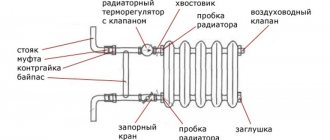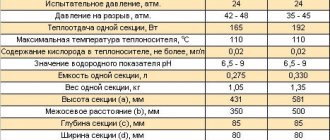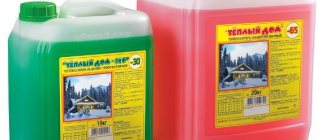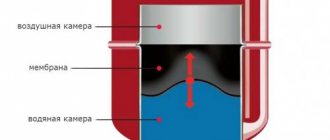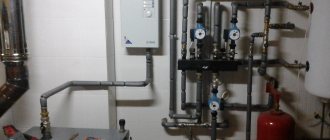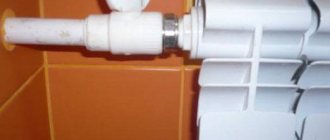Criterias of choice
A radiator valve is, as a rule, a ball-type device that regulates water flow and connects pipes to the radiator.
Installed on the bypass, risers, at the top of the battery, in places where air accumulates to bleed it. Choosing a suitable faucet is not difficult, just know a few nuances:
- the diameter of the pipes to which it will be connected (DN, in millimeters or inches);
- working pressure (PN, in the range of 15–40 and above);
- type of connection, presence of thread inside or outside, American.
The choice should take into account the purpose of the reinforcement, its location, and the properties of the environment
The ratio of the input and output of the valve in the radiator, their relative position is also important
When choosing, you should consider the characteristics of the cranes:
- Ball valves, although the most common and affordable, are not very effective. It has only two modes: closing/opening;
- a cone valve is a more acceptable option due to the possibility of an intermediate position. Disadvantage: the tap must be returned to its original position and constantly monitored;
- An automatic thermostat is the most efficient, reliable, but also much more expensive than others. When installing it on a one-pipe system, a bypass must be present.
How to choose the right one
It is important to know which taps to install on heating radiators. To do this you need to know their main characteristics.
The valve, designed for installation on a radiator, is most often presented in the ball type, which ensures regulation of the coolant flow and its temperature. It is also due to this element that the radiator is connected to pipes, which can be made of different materials.
The installation can be in different parts of the battery, which include the riser or the upper part. Can be mounted on bypass. Areas where air accumulates are selected so that, if necessary, it can be vented.
When selecting an element, you need to consider the following features:
- what diameter are the pipes for which the tap is purchased;
- at what operating pressure the product will be operated;
- what type of connection will be used to attach the tap, since individual elements may have threads;
- what is the purpose of the fittings itself;
- where should it be installed;
- what parameters and characteristics does the work environment have?
- properties of the valve input and output in a specific radiator.
Cranes themselves may have certain characteristics. These include:
The Mayevsky crane is considered the most popular choice because it is widely used, has an affordable price and excellent efficiency; The plug valve is considered an excellent choice because it can be installed in an intermediate position
It is important to regularly return this element to its original position, so you need to constantly review its condition; A thermostat equipped with automation is considered an effective and reliable element, but its price is quite high.
When choosing, you need to pay attention to the following parts of the taps:
- What locking mechanism is the faucet equipped with? Thermostats are equipped with two mechanisms at once: one is a valve, and the other is a valve with a special rod. The second option is considered the most optimal, since with its use the adjustment will be smooth and effective. The required temperature is set manually using a restrictive ring. However, there may also be thermostats with electronic mechanisms, but their price will be higher. The Mayevsky crane has many disadvantages in this regard. This is due to low traffic and the need to use a specialized wrench to use the crane.
- Crane body. The optimal products are those whose body is made of steel or bronze. The most popular are brass structures because they have an affordable price. You can often find faucets made of silumin, which is considered an analogue of brass. However, such options are considered unsuitable because this material is too soft. Polymer products are reliable, but they are usually produced in oversized sizes, so to install them you have to cut out too much of the pipeline. Also considered durable are taps in which gaskets are installed not from rubber, but from suitable polymers.
There are many types of taps that are installed on radiators of the heating system.
They differ in the ability to adjust the temperature, installation method, and various additional elements and parameters.
With the correct selection and proper installation of a tap on a heating radiator, you can increase the comfort of using the system, as well as its safety and efficiency.
Types of cranes
Ball
Ball valves have recently become very popular because they have an extremely simple design, which results in their long service life. In addition, they are easy to use, since to shut off the flow you only need to turn the handle 90 degrees.
The locking mechanism of this device is made in the form of a ball with a through hole. To block the passage, the ball should be turned with its hole perpendicular to the body.
The ball valve is controlled by a handle, which is connected to the ball via a rod. To seal the mechanism, two elastic rings are used that fit tightly to the ball.
The body of the ball device can be made of brass, aluminum or polypropylene. Plastic taps are installed together with plastic pipes for the heating system.
Pictured is an angle valve.
It should be noted that this fitting has the following disadvantages:
- Sensitivity to impurities in the coolant. Therefore, when using water, it is advisable to install filters.
- Not intended for smooth flow control. If it is used for these purposes, the mechanism will quickly fail.
Therefore, ball valves are often installed on the return line to completely shut off the coolant flow.
Valve device
Valve
A manual valve or manual radiator shut-off valve is a structure within which the direction of coolant flow changes twice. The closing element in such valves is a rod with an elastic gasket. The position of the rod is controlled by a worm gear with a handle.
When the gasket is pressed tightly against the seat, the coolant passage is closed. If you rotate the handle smoothly, the gasket will gradually open the passage. The advantage of this design is the ability not only to completely shut off the coolant flow, but also to regulate its intensity.
However, it should be borne in mind that the rubber gasket deteriorates quite quickly, as a result of which it does not seal the flow tightly. This problem can be solved by replacing the gasket, which is easy to do yourself.
Valve with thermostat for radiator
Shut-off valve with thermostat
A shut-off valve for a heating radiator with a thermostat allows you to regulate the intensity of the coolant flow automatically. This device is also called a thermal valve or thermal valve.
The shut-off valve design for this type of radiator is relatively simple.
Its locking mechanism consists of the following elements:
- Metal body with passage hole and seat.
- Elastic cone.
Valve device with thermostat
During operation of the device, the cone lowers and rises, as a result of which the amount of coolant passed through changes.
The position of the cone in the seat is controlled by a thermal head (thermoelement), which consists of the following elements:
- Cylinder (bellows).
- Thermal agent is a liquid or gas that fills the bellows. The thermal agent greatly changes its volume as a result of changes in ambient temperature.
- The piston is connected to a cylinder on one side and to a cone on the other.
Under the influence of temperature, the thermal agent contracts or increases in volume, which sets the piston in motion, which in turn changes the position of the cone through the rod. The thermal head allows you to regulate the temperature at which the valve completely shuts off the water.
It should be noted that there are two types of thermostats:
- Mechanical;
- Electronic.
Electronic model of thermal valve
The latter are usually equipped with a display and sensor that displays the air temperature. Such devices allow you to set the temperature conditions of the shut-off valve at different times of the day or even days of the week.
For example, from nine in the morning to five in the evening, when all household members leave, you can set the temperature to a lower value, and after five, the radiator will warm up to higher values and better warm up the room. The price of such devices, of course, is quite high.
Heating battery wiring diagram
Crane selection criteria
The plumbing market today is rich in various offers; everyone can find something that suits them in terms of price and quality. When purchasing and installing shut-off valves, you should clearly understand what each valve is for, and not clutter the structure with unnecessary parts - not only is this costly, it will also have a bad effect on the operation of the entire heating system.
Radiator taps are selected taking into account the type of device that is used as a coolant, as well as the type of heating system circuit.
Pipes of the appropriate diameter should be selected to minimize the number of valves used, and taps with maximum throughput should be selected.
The most durable and durable materials used in the production of valves are steel and brass. These are thick-walled products that will last longer, but when choosing, it is important to pay attention to the quality of the sealing gaskets.
Note! Modern sealing gaskets, which are used when installing faucets, are made not of rubber, but of silicone, since this material is not subject to destruction and does not lose elasticity when exposed to high temperatures, and as a result, lasts longer than rubber.
An important selection criterion is the manufacturer of the product. As a rule, products from reputable brands with a worldwide reputation are an order of magnitude superior to their analogues from little-known manufacturers. Companies whose products have been tested in domestic conditions and have proven themselves positively:
- Italian companies Itap and Luxor;
- German company Oventrop;
- Danish manufacturer Danfoss;
- joint Russian-Italian company Valtec.
We recommend that you familiarize yourself with: Types of pipes for a heating system in the floor under a screed and recommendations for selection
Natural and forced coolant circulation
It is worth noting that the method of connecting pipes to radiators will also depend on how the coolant circulates inside the heating circuit. There are two types of circulation - natural and forced.
Natural circulation of liquid inside the heating circuit is achieved through the application of physical laws, and no additional equipment needs to be installed. This is only possible when using water as a coolant. If any antifreeze is used, it will not be able to circulate freely through the pipes.
Heating with natural circulation includes a boiler for heating water, an expansion tank, 2 pipelines for supply and return, as well as radiators. In this case, a working boiler gradually heats the water, which expands and moves along the riser, passing through all the radiators in the system. Then the cooled water flows by gravity back into the boiler.
To ensure free movement of water, horizontal pipes are installed with a slight slope towards the direction of movement of the coolant. A natural circulation heating system is self-regulating because the amount of water changes depending on its temperature. When water is heated, the circulation pressure increases, which ensures uniform heating of the room.
In systems with natural circulation of liquid, it is possible to install a radiator with a bottom connection, provided there is a two-pipe connection, and also use a scheme with a top connection in a one- and two-pipe circuit. As a rule, this type of circulation is carried out only in small houses.
If the area of the house exceeds 100 m2, then the method of circulation of the coolant must be forced. In this case, you will need to install a special circulation pump, which will ensure the movement of antifreeze or water along the circuit. The power of the pump depends on the size of the house.
The circulation pump can be mounted on both the supply and return pipes
It is very important to install automatic bleeders at the top point of the pipeline or provide Mayevsky taps on each radiator to remove air pockets manually. The use of a circulation pump is justified in both one- and two-pipe systems with vertical and horizontal types of radiator connections.
The use of a circulation pump is justified in both one- and two-pipe systems with vertical and horizontal radiator connections.
What are radiator taps needed for?
For a general understanding, let’s clarify the terminology a little. In common parlance, faucets are any plumbing device that has a handle for manually controlling the flow of water. In fact, it is technically correct to call a faucet a shut-off valve, but not a control valve. That is, it is intended only to block the flow of liquid, and to regulate its quantity there are other devices - gates and valves. Moreover, all these products are used for batteries.
Shut-off and control valves are placed on the supply pipelines to heating devices for the purpose of:
- turning off the battery during periods of the year when it is not too cold outside or for other reasons;
- shutting off the water for inspection and washing of the device without emptying the entire pipeline network;
- manual or automatic control of coolant flow, adjusting its quantity depending on the room temperature.
Item one of the list illustrates well how installing taps on batteries is associated with energy saving. The situation when the central heating system is turned on during the warm period is not uncommon. It’s still quite warm outside, but the radiators are already glowing with heat, and the house is stuffy. If there is a tap, the problem is solved with one turn of the handle. And when a heat energy meter is installed on the entrance or the entire house, then with the same movement you block the flow of funds from the family budget to the account of the heat supply organization.
The same thing happens in a private house equipped with an individual heat source. Taps allow you to turn off part of the radiators in living rooms or temporarily used technical rooms, for example, in a garage
Equally important for saving money is periodic flushing of heating appliances. After all, what happens: a battery contaminated from the inside gives off less heat to the room, which means coolant with a higher temperature goes into the return pipeline
This coolant will heat your neighbors’ homes, but your apartment will feel a lack of heat. When it comes to a private house, the water returns back to the boiler and there are no losses. But the rooms become cooler and to obtain the required amount of heat you will have to raise the temperature of the heating system, increasing the fuel consumption of the heat generator. The pollution process is insidious because it takes some time and becomes noticeable only when the cost of heating the building increases.
The use of manual control valves or automatic valves with thermal heads makes it possible to save energy during the heating season by maintaining the required indoor air temperature. Manual valves for radiators allow you to adjust the coolant flow when setting up the system so that it does not go beyond the calculated limits. Valves with thermal heads control the flow of liquid automatically, reducing or increasing the flow area depending on the air temperature in the room.
Which faucet is better?
This question will only be answered when specific conditions and characteristics that are a priority are identified. In the absence of any need for regulation or automation, simple structures (for example, common ball valves) are quite suitable. If the priority is the function of maintaining the optimal air temperature in the room without much effort (automatic adjustment), then it is preferable to choose a thermal head. The problem with the thermal head is that it cannot be used in systems with central heating. A more economical option is to use valve balancing valves.
Why are there taps on radiators?
Each heating device is a separate element of the system that requires adjustment and periodic maintenance. If you control the coolant flow through the batteries depending on the heat demand, you can achieve good results in terms of energy savings. That is, radiator valves and heating taps are designed to solve the following problems:
- Complete isolation of the heating device from the system.
- Restriction of coolant flow through the battery.
- Change in coolant flow depending on external conditions.
- Bleeding air from the radiator and piping network.
There are many situations in which it is difficult to do without disconnecting the battery. For example, properly working central heating in the middle of spring, when it’s already warm outside, but it’s just hot in the apartment. Another case is the need to remove a heating device for the purpose of replacement, flushing or repair. In the absence of shut-off valves, carrying out any action with the radiator becomes problematic.
Valves are also installed on batteries in retro style
Restriction of the flowing coolant is carried out in order to balance individual heating in a private house or apartment
No matter what type of heating system you have, without balancing with valves, the first radiators will always receive more water than the last ones. Limiting the coolant flow at the beginning of the network and thereby balancing all devices with each other is the task of the control radiator fittings. Automatic control of the flow of incoming coolant is a way to save energy used to heat the house
If each tap on the heating radiator maintains the set air temperature in the room by controlling the flow of water through the radiator, then in general the system will consume only the required amount of heat, no more. And this is a considerable saving
Automatic control of the flow of incoming coolant is a way to save energy used to heat the house. If each tap on the heating radiator maintains the set air temperature in the room by controlling the flow of water through the radiator, then in general the system will consume only the required amount of heat, no more. And this is a considerable saving.
Well, the problem of air release when filling the system or during operation is also solved by special air valves installed on all modern radiators. Below is a list of types of shut-off and control valves, listed in the same order as the tasks they solve:
- Half-turn ball valves in straight and angle versions. Made from brass, bronze or polypropylene with a metal insert.
- Balancing valves for radiators – straight and angular.
- Regulating valves with thermal heads (thermostatic valves).
- Air drain valves – automatic and manual.
Now we should consider in detail which taps are best installed on radiators in various conditions and circumstances. Some options are clearly shown in the video:
Watch this video on YouTube
Valve balancing valve
The next type of taps for radiators are valve taps . The valve itself is used to provide such functions as:
- closure;
- opening;
- regulation of fluid flow power, etc.
For smooth operation of heating systems, it is recommended to use valve valves (balancing). They perform functions such as:
- optimal creation of hydraulic pressure;
- high-quality consumption of thermal fluid (generator).
Valve taps consist of the following parts:
- frame;
- spindle;
- gate;
- nipple.
All parts are made using brass, which has high resistance to zinc leaching. It is because of this that the valve does not need all kinds of additional coatings.
Balancing valves are divided into the following groups:
- manual valves (to reduce pressure in heating systems);
- automatic valves (for a stable difference between the pressures of the supply and return pipelines).
Requirements for the operation of the balancing valve:
- high resistance to the presence of various substances in the heat generator;
- the presence of a sufficiently wide range of regulation;
- there should not be a lot of noise during operation;
- ensuring complete blocking of the flow.
Typical dimensions of valve (balancing) valves
They are determined in the region of one inch. Diameters vary depending on model. Today, manufacturers in most cases mark cranes, indicating their exact dimensions and production characteristics. The markings indicate special symbols with which the indicators are deciphered (for example, D - diameter, P - working pressure).
Installation of valve taps on the battery
- First of all, the water is shut off and drained.
- Cutting out the area that was selected for installation (in accordance with the valve parameters).
- The selected location is being prepared.
- Making threads at the ends of pipes.
- Preparations to ensure good fixation of the valve.
- Connections that are attached with threads are sealed.
- Valve connection.
- Fixing the valve, sealing the threads.
- A setting is made that is responsible for the operation of the valve (in particular, its throughput).
- Filling the heating system with liquid.
Locking devices
The taps used for installation in the room heating system should be divided into two groups - shut-off and control. This division is largely arbitrary, since shut-off valves also allow you to regulate the movement of the coolant. Naturally, in this case the adjustment accuracy is quite low, but it is possible to cut off the battery from the water source.
Ball design diagram
The simplest and most commonly used type of valves are ball valves:
The ball valve is designed to shut off the radiator. Its design allows the device to be installed in either an open or closed position, so that the adjustment is carried out quite according to the principle “there is heat - there is no heat.”
Ball valves for heating radiators provide two-position adjustment
Please note! In principle, you can fix the valve in an intermediate position, but then the rate of its wear will increase many times due to the friction of particles suspended in water against the shut-off element. So it is better not to do this unless absolutely necessary
- The coolant flow is blocked by the movement of a metal ball with a hole coaxial with the pipe clearance. When you turn the faucet handle, the rod comes into action, which rotates the sphere inside the body, aligning the hole in it with the lumen of the pipe.
- As a rule, faucet parts are made of steel, bronze or brass. PTFE gaskets are responsible for sealing the connections and the locking part, which, if necessary, can be replaced with your own hands.
- Connection to the radiator is carried out either using a regular nut or using an “American” one.
Ball design with American
Unlike ball valves, cone valves make it possible to regulate the coolant flow more smoothly. This is ensured by the features of their design:
Sectional view of the device
- The locking element is a conical rod, on the surface of which a thread is applied.
- When we rotate the flywheel, the rod moves along the thread, moving in a vertical plane.
- In the lowest position, the pipe lumen is completely blocked. The tightness of the overlap is ensured by elastic gaskets that fit onto the annular grooves of the rod.
- By lifting the locking part, we open the gap slightly, and the coolant begins to flow into the radiator.
Please note! The indoor microclimate can only be adjusted approximately by decreasing or increasing the amount of hot water in each battery
Model in polypropylene case
In practice, bronze or brass cone valves for heating radiators are most often used: only systems are equipped with polypropylene, some of the pipes in which are also made of plastic. This is explained by the relatively low strength and wear resistance of polymers compared to sanitary alloys.
On the other hand, polypropylene taps for heating radiators are somewhat cheaper, so in conditions of budget deficit they can be used.
Mayevsky crane
When you pour coolant into the heating system, air gets inside along with water or antifreeze.
To remove it, special devices are used - the so-called Mayevsky taps:
Air release device
- The design of such a product is quite simple: it is based on a shut-off rod installed in a housing with a thread for the radiator plug.
- The rod is driven either by a screwdriver or a special wrench, opening the lumen of the pipe in the saddle.
Please note! If possible, buy valves for a screwdriver, since you will regularly lose the key, which is not surprising - you will have to use it once or twice a year. You need to keep in mind that the throughput of such a faucet is small, so, for example, you shouldn’t install it on an expansion tank: it will take about an hour to bleed off excess air. In such a situation, a regular valve or a water tap installed with the spout facing up is more suitable.
In such a situation, a regular valve or a water tap installed with the spout facing up is more suitable.
You need to keep in mind that the throughput of such a faucet is small, so, for example, you shouldn’t install it on an expansion tank: it will take about an hour to bleed off excess air. In such a situation, a regular valve or a water tap installed with the spout facing up is more suitable.
Photo of the installed valve
Ball valve and its device
Sectional view of a ball valve.
A ball valve is a type of shut-off valve that is designed to completely shut off the flow of coolant into a heating radiator. Using this device, it is impossible to regulate the amount of coolant supplied to the battery. The principle of operation of the mechanism is based on blocking the flow due to a locking element. Its function is performed by a ball with a through hole.
By turning the lever, a person turns the ball with a through hole inside the tap. Depending on the position of the latter, the flow of heated water into the heating circuit opens or closes. The lever can only be turned 90° in one direction or the other.
Ball locking mechanism.
Ball locking mechanism. As mentioned above, the locking mechanism here is a ball with a through hole. Sealing seats are placed on both sides of the ball. They perform two functions. Prevent coolant leakage into the pipe when the tap is closed. Provide the least resistance when turning the ball.
The locking mechanism is activated by turning the lever, which is located above the valve body. It is connected to the locking ball through a shaft (prevents the lever from being pulled out when the system pressure is high) and a washer (it is responsible for low sliding resistance when turning the shaft). The body of the device is made of either rolled steel or brass and its alloys.
Installation of ball valve. How to install a faucet on a radiator correctly? A specialist in his field will better answer this question, and therefore all work should be trusted only to him. If you plan to carry out the installation yourself, you need to take into account a number of nuances.
First, you need to choose the right faucet. For pipes whose diameter does not exceed 40-45 mm, a coupling device is suitable. For large diameter pipes (over 50 mm), flange valves (collapsible and monolithic) are purchased.
Thirdly, you need to clarify the type of tap thread and the direction of the coolant in it. The last parameter is easy to determine by the arrow, which is applied to the body of the locking mechanism. The tap thread can be internal or external on both sides. There are options where both types of thread are combined.
Work progress:
Questions about the operation of ball valves. During operation, people have a number of questions, which specialists are happy to answer. How to open the tap on a radiator at the beginning of the season? In this case, we are talking about the lower valve near the radiator, since the upper valve should be in the “open” position in the summer-autumn period.
Bypass is a pipe in front of the radiator that connects the supply and return.
So, before opening the tap on the radiator, you must wait 1 day after the start of the heating season. During these days, the quality of the coolant will noticeably improve. Then they proceed as follows: almost simultaneously, first the lower and then the upper locking mechanisms are opened. They wait a few minutes. If during this time the gurgling and gurgling in the radiator does not stop, then it is necessary to bleed the air from it. During the work, a Mayevsky crane is used.
How to replace the tap on a radiator? This question arises at the moment when the tap on the heating radiator is leaking. It’s bad if this is noticed after the start of the heating season and there is a centralized heat supply circuit in the room. After all, replacing the locking mechanism is carried out only when there is no coolant in the radiator. And only a technician from the organization providing the heat can drain the water from the system. In this case, the only solution to the problem is to call a technician to your home. It is not recommended to carry out work to replace a broken mechanism on your own.
If the heating battery tap is leaking in a private house where there is an autonomous heating circuit, then you can carry out the work yourself. But we must not forget about draining the coolant from the system. The work of replacing a faucet is no different from its original installation.
Ball valve
This is the most famous type of shut-off valve. Inside it there is a smooth ball that has a through hole and is capable of rotating 90°C, thus regulating the flow of water in the pipe, closing or opening it. The design of the mechanism provides it with minimal resistance to flow when open. It is designed to operate in the fully open or fully closed position to quickly shut off the water or, in some cases, drain it. Intermediate provisions are possible, but prohibited.
The materials for these mechanisms will be nickel-plated brass and stainless steel; for metal-plastic systems, polymer materials are also used. There are expensive and high-quality cranes from the Danfoss, Giacomini, and Bugatti brands on the market. For limited financial capabilities, Chinese and Turkish Valtec and Fado are offered. Good quality at a low price is offered by the Chinese AGUA-WORID.
The most common type of tap is a valve. Allows you to regulate the pressure. The flow channel inside it is perpendicular to the flow of liquid in the supply pipes. Installation must be carried out with careful attention to the markings so that water flows only in one direction.
For heating systems there are valves with a conical valve. They are most effective for such conditions. Fully open, it allows the maximum amount of liquid to pass through, which makes the thermal output of the battery more efficient. The mechanism allows you to reduce the flow of coolant and reduce heat transfer if the room is too hot and, thus, control the temperature.
There are these types:
- adjusting (straight and angular). They have manual control. Used in autonomous heating. They cannot accurately adjust heat transfer due to the lack of a scale and temperature sensor;
- equipped with a thermal head. Their design allows the temperature rise to be blocked or limited through manual or automatic control. Installed on two- and one-pipe systems. Adjustment is simple - the required temperature is set manually using a limit ring;
- with thermostat. Installed in front of the battery. The flow of coolant is controlled by a tap mounted in front of the thermostat.
There are no valve taps made of plastic; they are made from brass, steel or a combination of these materials.
Installation of taps on radiators
Before giving recommendations on which taps to install on heating radiators, let’s imagine 3 types of operating conditions for heating devices:
- in district heating systems;
- in private houses and apartments with an individual heat source;
- in apartment buildings equipped with an individual boiler room.
To begin with, we note that any valve or tap for a heating radiator can only reduce or block the flow area of the pipe, and not increase it. Accordingly, regulation by any means consists of reducing the amount of thermal energy supplied to the battery. In the case when it is not enough initially, there can be no talk of any regulation, only of blocking the flow.
With centralized heating of buildings, the quality of the coolant leaves much to be desired. Therefore, it is recommended to install good brass taps here. There is no point in installing valves and valves with thermal heads, since after a couple of years their working part may become clogged and control of the coolant will become impossible.
In centralized networks, pressure drops and water hammer often occur during seasonal start-up. The ball valve used in this case must be designed for a pressure of at least 16 bar. Based on the material, you need to choose a product of excellent quality, since in the warm season the system is usually emptied, which increases corrosion of metals.
For private homes, where there are all the possibilities for energy saving, valves with thermal heads are the best option. They are installed on the supply pipeline, and on the return line - a regular ball valve. Polypropylene products can also be used, but they often do not harmonize with the interior, so they are hidden behind a decorative screen.
Within the same room, there is no need to install thermostats on each radiator. The rule is this: valves are installed on one or more heating devices whose total heat transfer exceeds 50% of the total. The remaining radiators are equipped with supply valves and return ball valves.
Which fittings for radiators are best installed in apartment buildings with individual boiler rooms is determined only by the design documentation. As a rule, this type of heat supply is used in new buildings or after reconstruction of the entire heating circuit. It must provide all the necessary fittings. The maximum you can afford is to install high-quality brass taps on the connections.
Installation and connection of a valve for a radiator for heating
Depending on the layout of the heating system, hot water supply pipes to the radiator are supplied in different ways, and, accordingly, plugs and control valves are installed in different places. Before installation, it is necessary to shut off the coolant supply to the heating battery and drain the water.
If a single pipe system is used. where hot water flows through one pipe and heating devices are connected in series, a pipe enters the upper part of the battery and supplies coolant. It passes through the installation, exits from below on the same side and goes into the main line. In this case, the thermostat is installed on the bypass - pipe jumper. This jumper connects the forward and return pipes of the heating device and allows hot water to move after the pressure is blocked by the valve.
You can make a jumper with your own hands by welding a small diameter pipe (up to 8 cm) to steel pipes, having previously prepared the holes in the right places.
On a two-pipe system. where there is one pipe for the influx of coolant, and another for the outlet, there is no need to install a jumper; the thermostat is mounted on the water supply pipe.
Installing a radiator control valve is especially effective in an individual heating system, but in a centralized heating system it also gives a significant saving effect, provided that there is a hot water meter.
Why do you need a tap on a heating radiator?
Different types of taps used in the heating system provide solutions to various problems:
- Complete battery isolation. This need arises when the radiator is depressurized. By isolating a separate radiator from the entire circuit, you can repair or replace it without shutting down the entire heating system. They also turn off the taps completely if there is no need to heat the room where the radiator is located.
- Reducing the flow of hot water through the radiator. In this way, you can regulate the amount of heat generated by the heating battery in the room.
- Bleeding air and water using a Mayevsky tap. If compressed air accumulates at the top of the radiator, heating occurs much worse.
Mayevsky cranes
Heating systems are a closed circuit in which coolant constantly circulates. If an air lock appears in it, then the heat transfer of the system is significantly reduced. And this is the best thing that can happen. In such situations there are risks of system freezing. To eliminate such plugs in heating systems, a Mayevsky tap is used. The price of the device starts from 100 rubles. This is an inexpensive, but at the same time necessary and very effective device. If you turn the valve on the tap all the way, you can hear air coming out, if there is any. Once the entire plug has come out, the mechanism can be closed. Air is released from a hole with a diameter of 2 mm. This hole is located in a plastic gasket or in a brass housing. There is a simple or automatic Mayevsky crane on sale.
The price for automatic solutions is higher and starts from 350 rubles. But such devices are much more convenient.
Which taps are best to install?
If you do not need special temperature control, then it will be enough to install a regular control valve or ball valve. Such devices are very easy to install and simple to operate. Such taps are installed very often in apartments and houses.
Moreover, ball valves have only two positions, that is, either there is heating or there is not, control valves are able to regulate the flow and thereby reduce or increase the temperature in the house, but with such adjustment it is impossible to measure the exact flow and temperature.
If, on the contrary, complete and, most importantly, precise regulation of the air temperature in the room is required, then it is necessary to install thermostatic valves that can provide this.
Typically, such valves either have graduations corresponding to a certain temperature, and very advanced models have a small display showing the exact temperature, pressure and flow. Such devices are usually more expensive than previous ones, but provide greater comfort and convenience.
Radiator taps
Purpose
The definition of “ball valve” is equally applicable to a water tap and a valve. These two types of cranes are distinguished by location and purpose. The water tap is the end point of the water supply; the valve is installed between the elements of the water supply.
Ball valves for water supply are designed to completely shut off the main line or to regulate the flow. In shut-off valves, the design provides for two operating positions “closed” and “open”, excluding intermediate ones. To reduce the water supply, redirect the flow or mix two flows, ball valves of a different design are used, which are specially designed for these purposes.
A ball stop valve is installed on water pipes:
- for each branch of wiring to household appliances (water heater, washing machine, dishwasher);
- for each water supply line leading to the sink, bathtub, shower;
- for an individual outlet from the main water supply line (for introducing a water supply system into an apartment or house).
The installation scheme of an internal water supply system with the installation of a shut-off device on each section of the distribution somewhat increases the cost and complicates the installation of communications, but in the long term it is more profitable. In the event of a pipe break or failure of any household appliance, a ball valve allows you to quickly shut off the water supply to the problem area. At the same time, residents still have the opportunity to use running water.
A water-folding ball valve is installed separately for cold or hot water, and is also a common type of mixer. A ball mixer is a valve that is opened and closed not by rotating a knob, but by a lever, turning it left and right to adjust the temperature and up and down to control the flow force.
Ball valves are used in classic individual heating systems and when installing heated floors. Shut-off valves allow you to isolate individual radiators from the main system, thus regulating the temperature in the room. In the event of a radiator breakdown, this allows you to avoid stopping the heating operation for repairs.
The choice of shut-off valves for a heating system is limited by certain requirements for temperature and internal pressure. Not every ball valve is suitable for this due to its operational characteristics.
Tips for choosing
For home wiring without adjustment, it is enough to install ball valves on the devices. If used correctly, they will last a long time and be effective.
In apartments with central heating, it is recommended to install control valves with thermal heads. They do not clog so quickly and are capable of performing both shut-off and regulating functions.
The technical characteristics of the fittings can be determined by the markings stamped on the body of each product.
How to install correctly
They install a thermostat for a heating radiator at the inlet or outlet of the heating device - there is no difference, they work with equal success in both positions. How to choose a place to install?
According to the recommended installation height. There is such a clause in the technical specifications. Each device is configured at the factory - they are calibrated to control the temperature at a certain height and usually this is the upper radiator manifold. In this case, the heat regulator is installed at a height of 60-80 cm; it is convenient to adjust it manually if necessary.
Installation diagrams for heat regulators for radiators
If you have a bottom saddle connection (pipes fit only from the bottom), there are three options - look for a device that can be installed at the bottom, install a model with a remote sensor, or reconfigure the thermal head. The procedure is simple; the description must be in the passport. All you need is to have a thermometer and at certain moments turn the head in one direction, then in the other direction.
Installation is standard - on fum tape or linen winding with packaging paste
The installation process itself is standard. The valve has a thread. The appropriate fittings are selected for it or a matching thread is cut on the metal pipe.
One important point that those who want to install a thermostat for a heating radiator in apartment buildings should remember. If you have a single-pipe installation, they can only be installed if there is a bypass - a section of pipe that stands in front of the battery and connects the two pipes to each other.
If you have a similar wiring (there may not be a pipe on the right), a bypass is required. The thermostat should be installed immediately behind the radiator
Otherwise, you will regulate the entire riser, which your neighbors will definitely not like. For such a violation, a very substantial fine can be issued. Therefore, it is better to install a bypass (if not).

